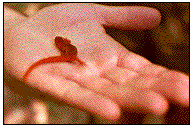The red-spotted newt, Notopthalmus viridescens, is among the many animal species which have been observed on the Hackett Hill property. In the spring, adult female newts lay jelly-covered eggs on underwater plants located at the edges of streams or ponds.These eggs hatch into larval forms. After 3-4 months the larvae make their way to moist land where they will spend 3-4 years undergoing further changes.The land forms assume a distinct red coloration and are known as "red efts". It is not uncommon to see red efts in the swamp communities, especially after a rainfall.
Each year, before winter begins, red efts move well into forested uplands where they hibernate in burrows under leaves, rocks, or logs. After several years as land-dwellers, the efts become adult salamanders. The adults are about 4 inches in length, have a red spotted exterior, and will return to watery surroundings to mate and lay eggs.
Importantly, the various habitats which newts occupy during their life cycle are often not in close proximity to one another, and the animals must traverse natural "corridors" to move from one area to another. In many cases, humans create impassable "barriers" in these pathways as a result of construction associated with development projects.
 On October 10,
1998, Pat Mattson, Shawn Wickham and Bob LaPree were crossing the
"phantom parking lots" on the Hackett Hill property on a day where
there was a lot of shower activity. Earlier they had observed red
efts like the one shown in the picture crawling about freely in
swampy regions. However about a third of the way across one of the
parking lots, a red eft was observed which was badly dessicated and
near death. It was placed in moist forest land well away from the
parking lot area and soon became quite lively. The red eft may have
left its swamp surroundings to forage for food, or it may have been
seeking a forested area where it would spend the winter. The
extensive pavement obviously became an impossible barrier for it to
cross.
On October 10,
1998, Pat Mattson, Shawn Wickham and Bob LaPree were crossing the
"phantom parking lots" on the Hackett Hill property on a day where
there was a lot of shower activity. Earlier they had observed red
efts like the one shown in the picture crawling about freely in
swampy regions. However about a third of the way across one of the
parking lots, a red eft was observed which was badly dessicated and
near death. It was placed in moist forest land well away from the
parking lot area and soon became quite lively. The red eft may have
left its swamp surroundings to forage for food, or it may have been
seeking a forested area where it would spend the winter. The
extensive pavement obviously became an impossible barrier for it to
cross.
The placement of parking lots (or similar barriers) in animal "corridors" which are essential to the continuation of a given species may eventually result in a decline in population size. Eventually there will be too few members of the species to sustain a "breeding population" - a happening which is made more likely by the recent world-wide decline in amphibian species. The species will then be extirpated, that is, become locally extinct - an effect which could probably lead to a cascade of other adverse effects on any natural community, such as a swamp, which the newt occupies at one stage in its life cycle.